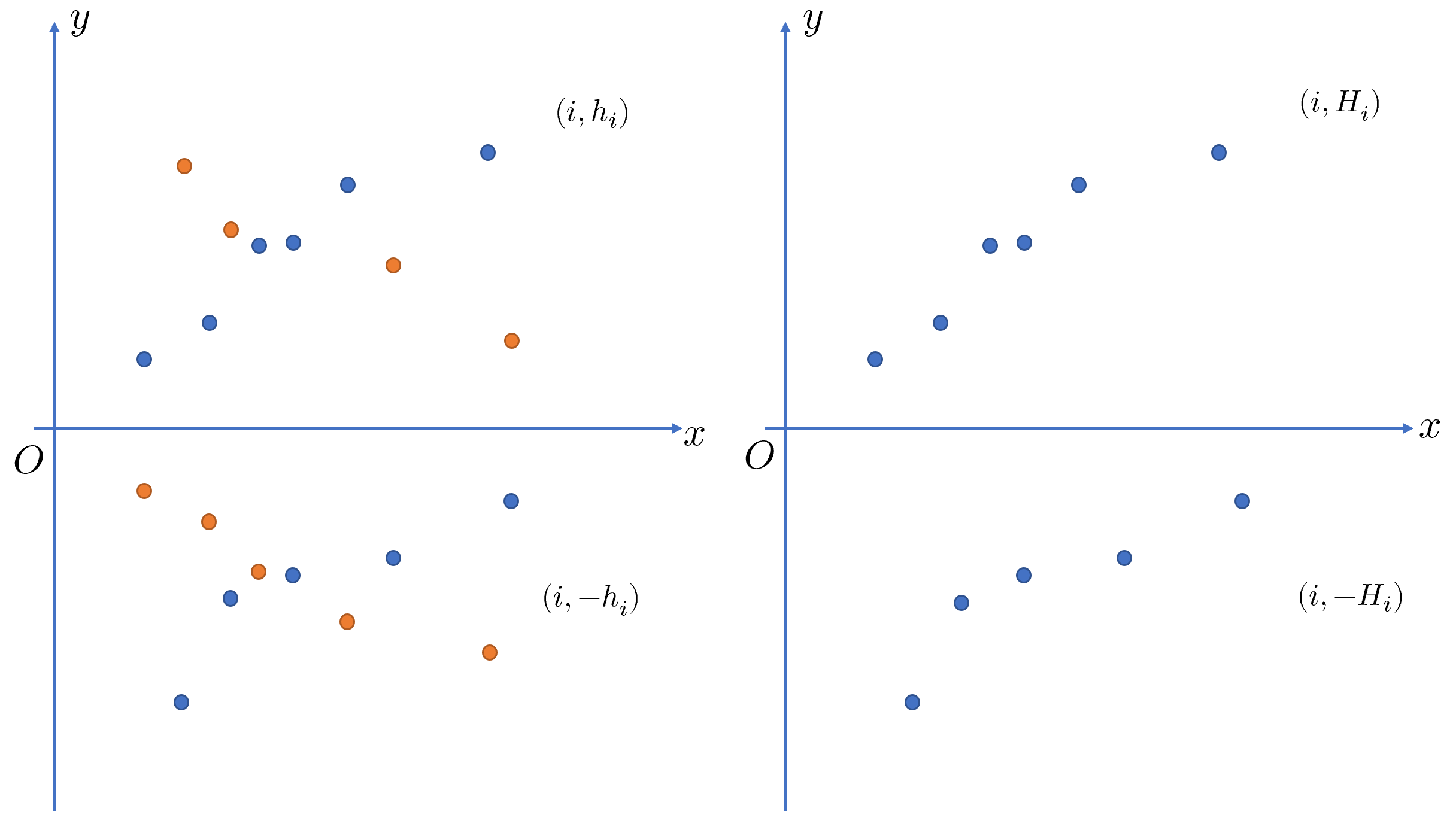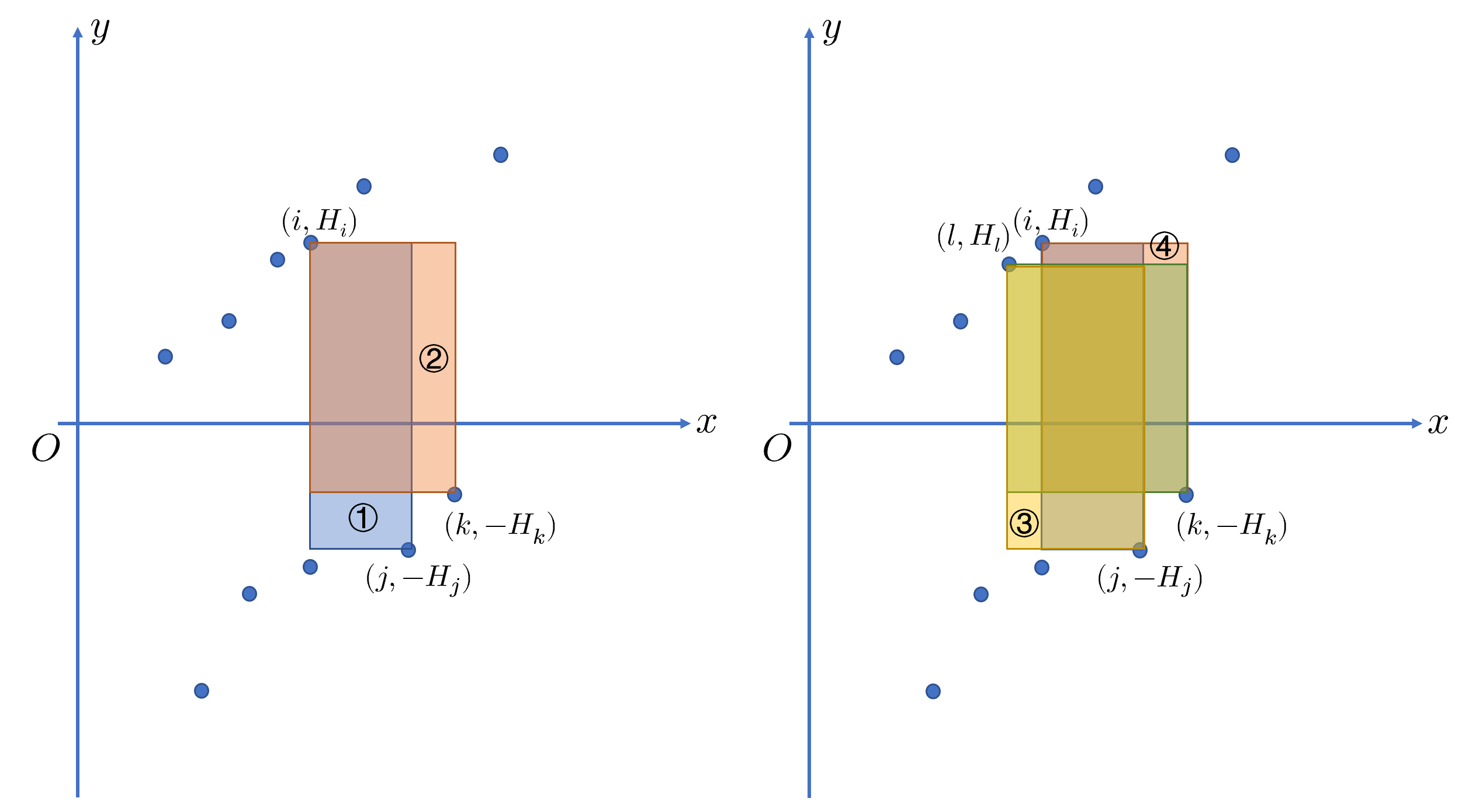Solution-CF102920L Two Buildings【分治】【决策单调性】
Solution-CF102920L Two Buildings 优秀的分治题目。是“2020-2021 ACM-ICPC, Asia Seoul Regional Contest”的一道题。

优秀的分治题目。是“2020-2021 ACM-ICPC, Asia Seoul Regional Contest”的一道题。
Description
There are $n$ buildings along a horizontal street. The buildings are next to each other along the street, and the $i$-th building from left to right has width $1$ and height $h_i$. Among the $n$ buildings, we are to find two buildings, say the $i$-th building and $j$-th building with $i<j$, such that $(h_i+h_j)*(j−i)$ is maximized.
For example, the right figure shows $5$ buildings, with heights $1$, $3$, $2$, $5$, $4$, from left to right. If we choose the first $2$ buildings, then we get $(1+3)*(2−1)=4$. If we choose the first and fifth buildings, then we $(1+4)*(5−1)=20$. The maximum value is achieved by the second and fifth buildings with heights $3$ and $4$, respectively: $(3+4)*(5−2)=21$.
Write a program that, given a sequence of building heights, prints $\max_{1\le i<j\le n}(h_i+h_j)*(j−i)$.
Input
Your program is to read from standard input. The input starts with a line containing an integer $n$ ($2\le n\le 1,000,000$), where $n$ is the number of buildings. The buildings are numbered $1$ to $n$ from left to right. The second line contains the heights of $n$ buildings separated by a space such that the $i$-th number is the height $h_i$ of the $i$-th building ($1\le h_i\le 1,000,000$).
Output
Your program is to write to standard output. Print exactly one line. The line should contain $\max_{1\le i<j\le n}(h_i+h_j)*(j−i)$.
Examples
input
5 1 3 2 5 4output
21input
5 8 3 6 3 1output
36
题意:
有 $n(2\le n\le 1000000)$ 栋楼房,第 $i$ 栋高度为 $h_i(1\le h_1\le 1000000)$。问两栋楼房所能构成的 $(h_i+h_j)*(j−i)$ 最大值是多少。
题解:
为了方便,我们把要求的式子转化为 $(h_i-(-h_j))\times(j-i)$,这样构造出数列 $-h_i$,就是坐标系中 $x$ 轴上方和 $x$ 轴下方两个数列中选出两个 $h$ 进行计算。
如果存在 $i<j$,同时 $-h_i<-h_j$,那么 $j$ 一定比 $i$ 更优。可以用单调栈来把数列 ${h_i}$ 和 ${-h_i}$ 都变为单调的。得到单增的 ${H_i}$ 和 ${-H_i}$。

如图,图中橙色的点删除后,对答案产生贡献的点只会在蓝色中产生。
而蓝色的点 ${H_i}$ 和 ${-H_i}$ 对应了两段递增的序列(此时下标 $i$ 不一定连续)。最终答案为 $[H_i-(-H_j)]\times(j-i)$。假设对于选定的 $H_i$,对应 $-H_j$ 为最优解,即 $\forall k>j,[H_i-(-H_j)]\times(j-i)\geqslant[H_i-(-H_k)]\times(k-i)$,可知
$$\begin{aligned}
[H_i-(-H_j)]\times(j-i)&\geqslant[H_i-(-H_k)]\times(k-i)\\
[H_i-(-H_j)]\times(j-i)\color{red}{-[H_i-(-H_k)]\times(j-i)}&\geqslant[H_i-(-H_k)]\times(k-i)\color{red}{-[H_i-(-H_k)]\times(j-i)}\\
[(-H_k)-(-H_j)]\times(j-i)&\geqslant[H_i-(-H_k)]\times(k-j)
\end{aligned}$$
因此对于 $l<i$,对上式进行放缩,得
$$\begin{aligned}\\ [(-H_k)-(-H_j)]\times(j-i)&\geqslant[H_i-(-H_k)]\times(k-j)\\ [(-H_k)-(-H_j)]\times(j-i)\color{blue}{+[(-H_k)-(-H_j)]\times(i-l)}&\geqslant[H_i-(-H_k)]\times(k-j)\color{red}{-(H_i-H_l)\times(k-j)}\\ [(-H_k)-(-H_j)]\times(j-l)&\geqslant[H_l-(-H_k)]\times(k-j)\\ [(-H_k)-(-H_j)]\times(j-l)\color{blue}{+[H_l-(-H_k)]\times(j-l)}&\geqslant[H_l-(-H_k)]\times(k-j)\color{blue}{+[H_l-(-H_k)]\times(j-l)}\\ [H_l-(-H_j)]\times(j-l)&\geqslant[H_l-(-H_k)]\times(k-l) \end{aligned}$$
所以当 $H_i$ 对应的最优解位置为 $-H_j$ 时,$l<i$ 的 $H_l$ 对应的最优解位置 $-H_k$ 满足 $k\geqslant j$。
如果上式推导过于复杂,它对应的图形推导如下。

左图中,如果 $H_i$ 对应的最优解是 $H_j$,那么①的面积 $S_1$ 一定比②的 $S_2$ 大。右图中,那么对 $l<i$,已知 $S_1\geqslant S_2$,有 $S_1+S_3\geqslant S_2-S_4$,所以 $l$ 对应的最优解一定不会在 $j$ 右边。
此时再考虑上边的推导,便能清楚理解了。
分治递归,时间复杂度为 $O(n\log n)$。
Code:
#include<cstdio>
#include<cstring>
#include<iostream>
#include<algorithm>
#include<cmath>
using namespace std;
#define ll long long
int a[1001000],b[1001000],c[1001000];
int bp[1001000],cp[1001000];
ll ans=0;
void solve(int l,int r,int L,int R)
{
if(l>r)
return;
int mid=(l+r)>>1,q=0;
ll Ans=0;
for(int i=L;i<=R;++i)
{
if(Ans<1ll*(cp[i]-bp[mid])*(b[mid]+c[i]))
{
q=i;
Ans=1ll*(cp[i]-bp[mid])*(b[mid]+c[i]);
}
}
ans=ans>Ans?ans:Ans;
solve(l,mid-1,L,q);
solve(mid+1,r,q,R);
}
int main()
{
int n;
scanf("%d",&n);
for(int i=1;i<=n;++i)
scanf("%d",&a[i]);
int ii=0,iii=0;
c[0]=1e8;
for(int i=1;i<=n;++i)
{
if(a[i]>b[ii])
{
b[++ii]=a[i];
bp[ii]=i;
}
while(a[i]>=c[iii])
--iii;
c[++iii]=a[i];
cp[iii]=i;
}
solve(1,ii,1,iii);
printf("%lld\n",ans);
return 0;
}